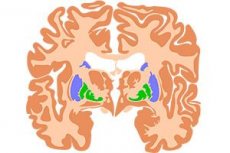Symptoms of the defeat of the basal (subcortical) nuclei
Last reviewed: 23.04.2024

All iLive content is medically reviewed or fact checked to ensure as much factual accuracy as possible.
We have strict sourcing guidelines and only link to reputable media sites, academic research institutions and, whenever possible, medically peer reviewed studies. Note that the numbers in parentheses ([1], [2], etc.) are clickable links to these studies.
If you feel that any of our content is inaccurate, out-of-date, or otherwise questionable, please select it and press Ctrl + Enter.

Subcortical basal nuclei are usually divided into two systems, based on the features of the histological structure: striatum (neostriatum) and pallidum (paleostriatum). The first include the caudate nucleus and the shell; to the second - medial and lateral pale balls associated with subtalamic nuclei (corpus subthalamicus Luysi), black matter (substantia nigra), red nuclei (nucl. Ruber) and reticular formation of the brain stem.
Numerous circular connections of the subcortical nodes of the base with the thalamus and extensive cortical fields (especially the frontal lobes) create complex extrapyramidal systems that provide automatic regulation of involuntary motor acts and participate in the regulation of voluntary movements.
When the basal nucleus is affected, there are disorders of motor activity - dyskinesia (hypokinesia or hyperkinesis ) and changes in muscle tone (hypotension or rigidity of the muscles). Most often with such localization of the lesion, there is Parkinson's syndrome.
Pallid-nigro-reticular syndrome: akinesia (hypokinesia, oligokinesia), plastic hypertension of muscles, symptom of "cogwheel", "wax doll", bradykinesia, bradily, propulsion, latency, retropulation, parkinsonical trampling on the spot, bradypsychia, paradoxical kinesia increase in postural reflexes , violation of posture and gait (head and torso bent forward, arms bent at the elbow and wrist joints and lower limbs in the knee joints bent at slightly presented in the hip joints), quiet mon ton voice aheyrokinez, rhythmic tremor at rest.
The syndrome of the lesion of the striatum (hypotonic-hyperkinetic syndrome): hypotension of muscles, chorea, athetosis, choreoathetosis, facial hemispasm or paraspasm, torsion spasm, hemitremor, myoclonus. When the subthalamic nucleus is affected, hemiballism. With pathology of the striatal department, complex hyperkinesis (eg, choreoathetosis) often occurs in combination with muscle hypotension, and in disorders in the pallidonigral system, muscle stiffness and hypokinesia are more common; There are also more simple types of hyperkinesis (stereotypic tremor, myoclonus).
With a predominantly cortical-subcortical localization of the lesion, various types of hyperkinesia-epilepsy are associated.


 [
[